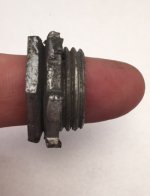catalytic
Cast Iron
- Joined
- Feb 4, 2010
- Location
- Boston, Los Angeles, and Cleveland
Does anyone know what this part is called?
It has 1/2" nominal NPT threads, and the inside is smooth. You use it (for example) to attach a conduit box to a motor's threaded hole, such that the motor leads can come out through it into the conduit box.
It's not a cord grip, since there's no gripping.
This one is made by Thomas Betts, but has no part number on it. I've been through my supplier catalogs and tried googling various terms with no luck. Stupid question I'm sure, but it's eating my day since I need a bunch of them.


It has 1/2" nominal NPT threads, and the inside is smooth. You use it (for example) to attach a conduit box to a motor's threaded hole, such that the motor leads can come out through it into the conduit box.
It's not a cord grip, since there's no gripping.
This one is made by Thomas Betts, but has no part number on it. I've been through my supplier catalogs and tried googling various terms with no luck. Stupid question I'm sure, but it's eating my day since I need a bunch of them.




